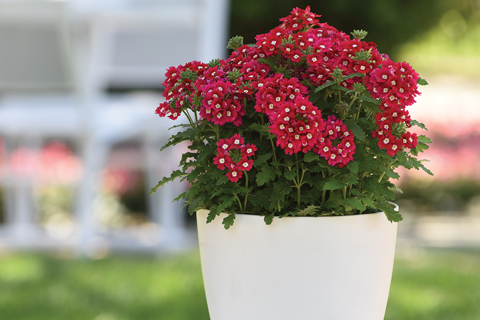11/1/2019
Being Flexible & Fluid
Luís Muñoz

In this industry, we’re always seeking to make the most out of the limited resources we have. We look for opportunities to improve our efficiency, whether it’s to reduce energy consumption, integrate new technology or look for new products that will maximize the use of our resources.
This makes the way we manage greenhouse operations crucial because it will ultimately be a deciding factor of whether our grow-out will be affordable. With rising costs of production, materials and labor, we need to adjust and find new ways to be more productive. Not only should we explore areas where we can conserve resources, but look for products that can maximize the use of these resources.
Pictured: Cadet Upright Red Verbena.
As some of our facilities expand and are updated, we look for opportunities to make changes. The flow of work may change to improve efficiency, the old loading dock may become the new warehouse for new automation machinery, the new loading area may no longer be centralized, but be built at the end of the production line, or the old soil machine may no longer meet the capacity needed. As time passes, our focus and needs change, making it important for us to have the flexibility to adapt to new challenges.
Just like designing our facilities correctly and all the instruments operating them to meet our needs, we need to do the same for our crops. As always, we likely prioritize high-value crops that will bring the most income and keep them in the best environment possible. This is usually where most energy and labor inputs are invested. We’ll use greenhouses that can cool or heat the most and with the best environmental controls to maximize and control growth, allowing us to ensure the quality of our most valuable grow-outs and reserve less valuable space for crops with fewer requirements. It’s part of managing the resources and space available for use.
One may think that areas with fewer resources available will likely not provide the ideal growing conditions. In areas like this, we may decide to place lower-value crops, which can be a way to maximize space usage, but so can picking a product whose ideal conditions fit the conditions that can be provided. We may decide to use optimal greenhouse space for a new crop and decide to move out some verbenas that will likely handle cooler outside tunnel-growing conditions. Not only will growing under outside tunnel conditions free up some greenhouse bench space, resources and energy inputs, but growing under cool nights can help control growth. Growth can be slowed down and cool nights will likely reduce the amount of PGR applications needed for a well-toned quality plant. We get the added benefit of saving time, chemicals and labor.
Products like Cadet Upright Verbena can be great to implement into a growing program because of their unique habit that makes them ideal for 1-qt. production. Cadet’s upright habit allows growers to maximize space usage because of their ability to be grown pot tight. Products like Cadet will not only maximize space, but can also allow for a high-quality grow-out with a quick finish. Having a quick-finishing product means plant material will occupy bench space for a shorter period of time. The faster we free up space, the sooner resources can be shifted elsewhere. It may be space for a new crop or simply reducing the amount of labor needed.
Focusing on efficiency doesn’t always have to be about reducing energy costs or looking for alternative materials. We can look for products that will provide the potential to produce more plants per square foot, be grown in cool and lower-resource areas, reduce energy costs and chemical inputs, and have a quick finish to save time and money.
So just like correctly designing a greenhouse operation to ensure we have a smooth workflow, or implementing new technology to increase efficiency, we have to be sure to plan out our next growing program. Look for opportunities where we can not only be more efficient to save energy and costs, but that can ultimately lead to other benefits like greater quantity and quality of plants grown. Take opportunities that will not only allow us to maximize our use of areas with fewer resources, but that will lead to an increase in outputs and reduction of inputs/resources. GT
Luís Muñoz is Culture Research Technician for Ball FloraPlant in Arroyo Grande, California.